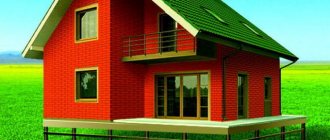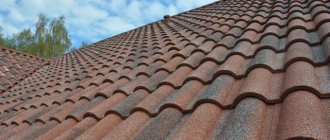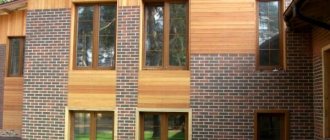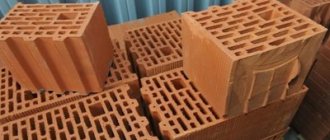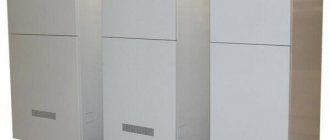The quality of the soil has a great influence on the choice of foundation and the entire construction technology in general.
In Russia there are a large number of problem regions where swampy, flooded or weak-bearing soil types predominate.
The use of a traditional foundation in such conditions is unacceptable, but pile types of support structures come to the rescue.
They ensure contact of the base with dense layers of soil and allow the construction of massive and heavy buildings without fear for their condition.
There are also lighter options for pile foundations, which include screw piles.
Foundation on screw piles
Screw piles are a supporting structure in the form of a system of metal pipes immersed in the ground with spiral blades welded at the bottom (photo below) . They play the role of cutting, similar to that done on screws.
The pointed conical tip allows the trunk to enter the ground more easily, and the blades perform the cutting function and in parallel serve as support units.
The submerged support is kept stationary due to the frictional force between the side walls of the pipe and the ground, as well as due to the load on the blades. The installation is carried out according to a certain scheme, forming the so-called. a pile field that ensures uniform load distribution across all shafts .
After immersion, the upper parts are trimmed to form a flat plane and tied with a load-bearing belt - a grillage.
It provides a supporting structure for the walls and evenly transfers the load to the pile system.
The functions of the grillage are close to the operation of a strip foundation, but the support for it is not the ground surface, but the upper ends of the vertical rods. To strengthen the structure, hollow pipes are filled with compacted concrete after installation, which makes them immune to possible lateral loads .
IMPORTANT!
Installation of screw piles does not require immersion until contact with dense layers of soil occurs. With sufficient depth, they quite reliably hold the building, being a hanging type of piles.
Types of permafrost soils
VG includes geological strata that have been frozen for several thousand years. The characteristics and thickness of VG layers are mainly predetermined by the local freezing level and the annual average ambient temperature. Therefore, in a certain area in neighboring areas, the thickness of frozen soil may vary significantly or be completely absent.
Based on their texture structure, VG is divided into several types:
- fused;
- layered;
- cellular (cryogenic).
Slitnaya
This VG texture consists mainly of ice cement with the absence of large inclusions. Occasionally, small nested ice inclusions are found in such soil. In most cases, this structure predominates in coarse, gravelly and sandy soils.
Layered
This type of frozen formation is observed in clayey and sandy silty soils. This texture property is usually found in ground massifs of VG with a thickness of 12 to 27 m or more. The layered structure of the VG is formed as a result of unilateral freezing of waterlogged soil, fed by migratory water inflow from the underlying soil layers. Such a foundation is practically unsuitable for construction.
Cellular
The network structure of the VG is the result of freezing of clayey silty soils. This is facilitated by strong waterlogging of the massif with a free flow of water. Soils with a cellular structure are usually located in the upper part of the active layers.
Advantages and disadvantages
The advantages of screw piles include:
- High installation speed.
- Possibility of manual installation, which allows you to work in close proximity to finished buildings.
- The cost of screw piles is much lower than other types of foundation.
- Possibility of reuse. If necessary, the piles can be removed and used elsewhere.
- No excavation required for installation.
- It is possible to build on slopes or folds of the terrain.
- You can do without the use of complex equipment.
The disadvantages are:
- Operating conditions promote corrosion.
- The use of screw piles in regions with high seismic activity is prohibited.
- Immersion in rocky soil is not permitted.
- The use of screw piles on loose or weak-bearing soils that do not provide sufficient lateral support requires additional examination and clarification of the immersion depth.
Most of the shortcomings are often hushed up by manufacturers, so it is necessary to have a complete understanding of the properties and qualities of the design.
Why is it profitable to build in winter?
However, be that as it may, construction in winter also has some positive properties:
- Relatively cheaper construction. This applies to both materials and wages for builders.
- The overall construction time does not increase due to winter downtime, which is especially important when you urgently need to change your place of residence
- Some of the main work is carried out in winter, and finishing begins in summer.
- It is better to move into a house in the spring, when during the warm season there is an opportunity to eliminate any deficiencies
Well, and besides, there are also everyday advantages that you can take with a smile:
- No heat
- No mosquitoes
- Lack of rain, which can permanently stop any construction
Moreover, in some cases, winter construction even looks preferable - for example, when laying a foundation in swampy areas or on reservoirs, which will be discussed in more detail below. In addition, it is along the “winter road” that it is possible to get to other wildernesses - for example, to the same swampy areas. This applies mainly to industrial construction, but is also typical for other private landholdings.
Types of supports
Let's consider what types of screw supports are used in modern construction:
By area of application
This type of foundation is used much more widely than it might seem at first glance.
Screw piles are successfully used in the following areas:
- Capital construction.
- Individual residential construction.
- Bridges, piers, other hydraulic structures.
- Load-bearing supports of power lines, masts, etc.
- Hangars.
- Greenhouses.
- Fences or enclosures, etc.
The rise in popularity of this type of base has greatly expanded the range of applications, and the process is not over yet..
Dimensions
Steel pipes of different diameters are used . The most common pipes are 108 mm; this size provides a fairly high load-bearing capacity with good penetration into the ground.
The general range of pipe diameters is between 57-219 mm, but in some cases thicker supports are used .
In private housing construction, pipes larger than 159 mm are not used due to the difficulty of immersion.
The length of the pipes also has many options . There are standard sizes from 1650 to 9000 mm, used in appropriate conditions.
The lower the strength and density of the soil, the longer the trunk should be.
Number of blades
There are single and multi-bladed designs. Single blades are used on relatively stable soils.
Exceeding the load or reversing the pile during installation leads to loss of adhesion to the ground.
For critical buildings on weak-bearing soils, multi-bladed piles are used, which demonstrate greater resistance to possible loads.
In addition, increasing the number of blades allows you to reduce the diameter of the barrel, which makes diving easier.
At the same time, the thickness of the walls must provide the necessary rigidity.
Tips
The tip takes on the load when immersed, which puts forward quite stringent requirements for its design.
Exist:
- Welded tips . They are made by narrowing the diameter of the pipe by removing wedge-shaped sections and connecting the resulting fragments into a cone. The seams are welded and a pointed end is formed. Used for relatively weak, soft soils.
- Cast tips . They are manufactured (cast) separately and attached to the pipe. They are thick and capable of destroying obstacles. Used on dense and difficult soils.
Material of manufacture
Different grades of steel are used - from the usual St 3 to the more durable St 20.
For use in highly aggressive soils with heavy loads and the possibility of electrostatic corrosion, durable steel grades 30 KhMA and 09G2S are used.
Type of protective coating
The most effective coating is considered to be a layer of zinc. At the same time, the material itself must be sufficiently resistant to corrosion .
Polymer materials applied to the piles are erased during immersion and cannot fulfill their task.
They are necessary only to protect the outer part of the supports and require periodic updating.
Many engineers offer their own protection options, from mastics to applying a layer of rubber, but these methods have not yet become widespread.
Comparison with other options
Only knowing all the advantages and disadvantages of the pile-screw structure, as well as the features of strip foundations with the pros and cons of the technology for constructing and operating the building fixed on it, can you make the right choice. The strip base is characterized by:
- possibility of shallow laying on dry, non-heaving soils;
- convenient arrangement of the burial space;
- the opportunity to do everything with your own hands;
- it takes a certain time for the concrete solution to completely cure;
- used to strengthen brick and concrete buildings;
- a significant increase in costs for areas with severe soil freezing.
It should be noted that the arrangement of a strip base in the cold season is accompanied by an increase in labor intensity and costs.
Strip base Source nl.decorexpro.com
There are several other types of foundations based on the use of piles, which are popular in individual construction.
Pile-tape construction
The most advanced option is considered to be a pile-strip foundation, the pros and cons of which reflect its effectiveness in the most difficult cases:
- for a building made of brick or reinforced concrete structures;
- mobile heaving soils;
- groundwater, high humidity;
- difficult terrain, slope.
Pile-strip foundation Source vologdadom.com
Piles are installed to a depth of up to 2.5 m, which ensures increased reliability and stability of the foundation of the house.
Reinforced concrete piles
The construction of a house in areas with problematic soil, including coastal areas, steep slopes, peat bogs, deep freezing, is carried out on a foundation on reinforced concrete piles, its pros and cons are as follows:
- design work is complex and must be performed by a professional;
- allows you to obtain the maximum possible stability and rigidity of the foundation;
- suitable for heavy buildings;
- high cost of materials and work;
- use of specialized equipment.
Piles made of reinforced concrete Source svoisvai.ru
The length of reinforced concrete piles reaches 11 m. In private construction, elements about 3 m long are used, which weigh at least 700 kg.
House on a pile-screw foundation Source kursremonta.ru
Which ones are most optimal for use in country house construction?
It is impossible to name the optimal type of screw piles without analyzing the soil or calculating the weight of the house.
If we proceed from the specifics of the construction, which involves the creation of a relatively light house with a small number of floors, then the most appropriate option would be to use single-bladed trunks with a diameter of 57 to 108 mm, depending on the type and condition of the soil .
More detailed information will only be provided by surveying the site and calculating the load, since the pile has a certain limit. For example, with a diameter of 57 mm, the maximum load will be 800 kg .
For what buildings is it needed?
Screw piles can be used for various buildings. World practice has shown the ability of this type of foundation to successfully work with massive, heavy and tall buildings and structures.
However, in Russia the technology for creating this foundation has not yet been developed, so they are usually limited to the construction of auxiliary or outbuildings. For residential buildings, screw piles are used reluctantly and quite rarely.
Features of winter foundation laying. Possible difficulties and ways to eliminate them.
The most popular foundation remains the strip foundation. In this case, there should be no freezing of the foundation with groundwater during the excavation process. It is also necessary to add substances to the solution to reduce the degree of concrete freezing. It will be possible to avoid rapid hardening of the solution when pouring. For this purpose, timely heating of the filling is also provided. This method violates the norms and current standards, but is also indicated in the regulatory documentation. Although severe frost will not allow heating or various additives to help avoid freezing, a truly high-quality laying is not always possible.
Working in subzero temperatures results in less productivity, more regular rest is required, and more time is needed for certain tasks. For some “wet” jobs, you can reduce the volume or even reduce their number. Accordingly, you need to use ready-made blocks produced directly at the factory. They are placed in the finished foundation pit. This foundation requires relatively little mortar, so it is possible to reduce the necessary wet work.
The foundation can be made on ready-made piles of similar concrete. When building a not very large house, it can be recommended to abandon the strip foundation for the sake of pile technology
. Often this choice is made for the construction of wooden houses. If all the rules for constructing a pile foundation are followed, it is possible to ensure strength and reliability.
Concrete piles can be bored or bored. In the first case, ready-made piles are driven into the ground, in the second, the drilled holes are filled with concrete. In winter, the first option is more preferable, because in this case you will not need to prepare and pour the solution yourself. But the disadvantages include not only the high cost, but also the high noise level during the work process.
Life time
Under ideal conditions (soil that does not have a destructive effect on the material, no corrosion, etc.), the support can last up to 300 years , and if there is a galvanized layer, up to 800 years.
This is what manufacturers and marketers say, although they have no basis for this. Not even 299 years have passed since the invention, so such statements cannot be taken seriously. Ideal conditions do not exist, and impacts and normal metal fatigue have not gone away .
Therefore, the real service life of such a foundation should be considered 50-75 years, although deviations in one direction or another are possible.
NOTE!
Some of the structures that were first built on screw piles by their inventor, Mitchell, are still standing and in use today.
Is there a difference between cast screw and welded pile caps?
There are no significant differences between these products. Cast tips are made from standard steel marked 35L. The main difference between these support elements is that the screw lines are not welded to the pile cones, but are immediately cast together with them. However, few people know that cast ends are actually welded to the pipe. This means that when using them it will not be possible to avoid welds.
If we talk about the disadvantages of cast tips, then during their production it is necessary to control the level of casting quality. In addition, their production is impossible without the use of ultrasonic equipment. The fact is that the material from which the product is made may contain small cracks, pores and voids, which will significantly reduce the strength characteristics and service life of screw piles.
Welded tips can be checked independently, since even with a visual inspection it becomes possible to assess the quality of production of the products. Piles with cast lines cost almost 25% less.
Is this a capital foundation or not?
Screw-in piles are capable of supporting very heavy and massive buildings or structures. Therefore, they should be considered a capital foundation by right.
In this matter, a certain psychological imbalance arises, since outwardly they do not look like a reliable support corresponding to the term “capital”.
However, the main feature is the permissibility of use in the construction of residential buildings.
This allows us to reasonably consider screw piles as a permanent type of foundation.
How to make the right choice?
The selection of screw piles consists of two stages:
- Determining the appropriate size and type of screw piles.
- Selection of specific products based on quality and compliance with requirements.
The first stage is almost entirely carried out during the design of the house. Therefore, there is no point in talking about it.
The second stage is usually carried out by representatives of the company with which the contract is concluded.
If for some reason you have to choose on your own, you should pay attention to the following details:
- The thickness of the pipe walls should not be less than 4 mm.
- The thickness of the blades is at least 5 mm.
- The quality of welding must be as high as possible.
- The presence of a galvanized layer.
- Tip type and quality.
Using these criteria, you can choose the best quality products.
IMPORTANT!
If any items do not meet the established requirements, it is better to refuse to purchase such piles.
Checking the grounding system
When the installation is completed, you need to test the resistance of the ground loop. In accordance with the rules for electrical installations, the resistance indicator for an electrical network with a voltage of 220 Volts should not exceed 30 Ohms.
Measurements are carried out in dry weather (during such periods the greatest soil resistance is observed). If the measurement results are within the normal range, the trench with the grounding loop is covered with earth, after which the grounding is ready for operation.
Grounding connection rules
What is the problem, why can’t you connect the ground wire to heating or water supply pipes?
And now the question is - what will happen to the neighbor if he, sitting in the bathroom (connected to the sewer by opening the plug) touches the tap? Did you guess it?
The prize is prison. Under an article about violation of electrical safety rules resulting in casualties.
"Grounding" and "grounding"
Ideally, the “grounding loop” should consist of 3 - 4 corners, which are welded with a metal strip of the same width. The distance between the corners should be 2 m.
Just don’t drill a hole in the ground with a meter-long drill and lower the pin there. It is not right. And the efficiency of such grounding is close to zero.
But, as with any method, there are downsides. You are, of course, lucky if you live in a private house, or at least on the first floor. But what about those who live on the 7th-8th floor? Should you stock up on 30-meter wire?
So how to find a way out of this situation? I’m afraid that even the most experienced electricians will not give you the answer to this question.
What is required for house wiring
We must also not forget that the “earth” has no right to be broken by means of any switches.
How much does a foundation like this cost?
Let's consider the cost of a screw foundation for a small house 6:6 m. The optimal layout of a pile field consists of 9 piles.
Then the owner of the site will be required to pay for the installation of 9 pieces (cost from 650 to 1100 rubles / piece) and the price of the piles themselves.
It depends on the length and diameter - for example, VS-57 (diameter 57 mm) 3 meters long costs 1100 rubles with installation or 1200 without installation.
If you decide to use VS-108, then the price without installation (for a 3-meter trunk) will be 1150 rubles with installation and 1350 without installation. The difference in purchase price with and without installation is intended to encourage ordering installation from this company.
As a result, the cost of the foundation will be about 20,000 rubles. But this amount does not include delivery and other overhead costs, so it is necessary to have some reserve.
Prices at other companies may differ; this must be clarified directly on site..
Brief and general installation diagram
Procedure:
- Marking the pile field.
- Screwing piles.
- Filling the pipe cavities with concrete, trimming the tops to obtain a flat surface.
- Installation of headers.
- Installation of grillage.
It is recommended to carry out installation using special machines. This makes it possible to ensure verticality and the absence of rocking of the pile when screwing, which promotes maximum close contact with the ground . Welding areas and those damaged during the process are tinted with a protective anti-corrosion compound.
Summing up
And in conclusion, I would like to note that, knowing the whole truth about the service life of metal piles in fresh water and aggressive environments, you can build a truly reliable and durable foundation in a short period of time that will last for decades. The main thing is to follow the manufacturing process of supports and the installation technology of such building elements.
During operation, the foundation of any building is exposed to the harmful effects of moisture, low temperatures, stray currents and various aggressive environments. To prevent its possible destruction, developers must build a reliable foundation structure that can withstand negative factors. For areas with difficult soils and close proximity to groundwater, the ideal solution would be a screw foundation, which uses various rolled steel.



